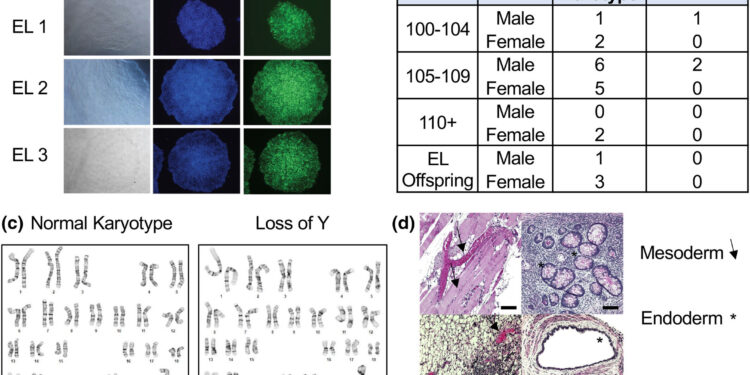Representative characterization of EL-specific iPSCs. (a) Representative images of iPSC lines under brightfield (left), DAPI (middle), and TRA-1-81 (right). Images taken at 10× magnification. (b) Table of generated iPSC lines including demographic information (age, sex) and karyotype result based on g-banding analyses. (c) Representative karyotype reports of male EL iPSCs showing normal karyotype (left) and mosaic loss of the y chromosome (right). (d) Representative images of hematoxylin and eosin stains of teratoma mass from EL iPSC lines representing mesoderm (arrows), endoderm (asterisks), and ectoderm (accent) tissue. Scale bars: 100 μM. Credit: Cellular aging (2024). DOI: 10.1111/acel.14351
Individuals with exceptional longevity provide evidence that humans can live longer and healthier lives. Centenarians (over 100 years of age) provide a unique vantage point for studying longevity and healthy aging because they have the potential to delay or escape age-related diseases such as cancer, cardiovascular disease, and Alzheimer’s disease, while significantly avoiding disability. The problem is that models of human aging and disease resilience that can be used to test potential interventions are virtually nonexistent.
To address this problem, researchers at Boston University Chobanian & Avedisian School of Medicine and Boston Medical Center (BMC) have created the world’s largest library of induced pluripotent stem cells (iPSCs) from centenarians and their offspring. iPSCs can be grown indefinitely, differentiate into any cell or tissue type in the body, and faithfully capture the genetic makeup of the person from whom they are created.
The work is published in the journal Cellular aging.
“By creating centenarian stem cells, we hope to understand how these individuals delay or avoid age-related diseases and develop and/or validate therapies in this same capacity. This research provides a unique resource that can be used to better understand the mechanisms underlying centenarian resilience and help others maximize their healthy years of life,” said first author Todd Dowrey, a doctoral candidate in the school’s Department of Molecular and Translational Medicine.
The researchers obtained and characterized more than 100 peripheral blood samples from centenarians and descendants, including those containing data on their resistance to disability and cognitive impairment. The team analyzed how gene expression is regulated in the molecular clocks of aging to compare and contrast the differences between biological and chronological age in these specialized subjects.
The isolated peripheral blood mononuclear cells were then successfully reprogrammed into high-quality iPSC lines that were functionally characterized for pluripotency, genomic stability, and the ability to expand and differentiate into multiple cell types.
The researchers also found that centenarians and their descendants had significantly younger biological ages. Some individuals had a difference of up to two decades between biological and chronological ages.
According to the researchers, this work highlights the important and growing link between regenerative medicine and the biology of aging.
“By harnessing our ability to study the resilience of centenarians ‘in a petri dish,’ we hope to unlock a detailed road map to healthy living, disease resistance and longevity,” said corresponding author George J. Murphy, Ph.D., associate professor of medicine at the school and co-founder of the BU and BMC Center for Regenerative Medicine (CReM).
“Our participants are always incredibly generous, and without them we would not be able to conduct these unique studies. In return, we hope to continue their legacy as the stem cell lines we create from them will last forever and be used by researchers around the world,” added study co-author Dr. Thomas T. Perls, professor of medicine and founding director of the school’s New England Centenarian Study.
More information:
Todd W. Dowrey et al., A longevity-specific bank of induced pluripotent stem cells from centenarians and their offspring, Cellular aging (2024). DOI: 10.1111/acel.14351
Provided by Boston University School of Medicine
Quote:Researchers Create Largest Stem Cell Repository Focused on Centenarians (2024, September 25) Retrieved September 25, 2024, from
This document is subject to copyright. Apart from any fair dealing for the purpose of private study or research, no part may be reproduced without written permission. The content is provided for informational purposes only.



